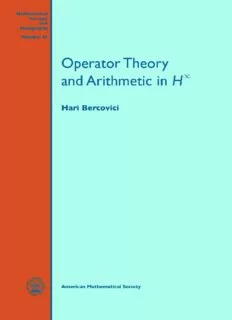Table Of Contenthttp://dx.doi.org/10.1090/surv/026
MATHEMATICAL SURVEYS
AND MONOGRAPHS SERIES LIST
Volume
1 The problem of moments, 16 Symplectic groups,
J. A. Shohat and J. D. Tamarkin O. Timothy O'Meara
2 The theory of rings, 17 Approximation by polynomials
N. Jacobson with integral coefficients,
Le Baron O. Ferguson
3 Geometry of polynomials,
M. Marden 18 Essentials of Brownian motion
and diffusion, Frank B. Knight
4 The theory of valuations,
O. F. G. Schilling 19 Contributions to the theory of
transcendental numbers, Gregory
5 The kernel function and
V. Chudnovsky
conformal mapping,
S. Bergman 20 Partially ordered abelian groups
with interpolation, Kenneth R.
6 Introduction to the theory of
Goodearl
algebraic functions of one
variable, C. C. Chevalley 21 The Bieberbach conjecture:
Proceedings of the symposium on
7.1 The algebraic theory of
the occasion of the proof, Albert
semigroups, Volume I, A. H.
Baernstein, David Drasin, Peter
Clifford and G. B. Preston
Duren, and Albert Marden,
7.2 The algebraic theory of
Editors
semigroups, Volume II, A. H.
22 Noncommutative harmonic
Clifford and G. B. Preston
analysis, Michael E. Taylor
8 Discontinuous groups and
23 Introduction to various aspects of
automorphic functions,
degree theory in Banach spaces,
J. Lehner
E. H. Rothe
9 Linear approximation,
24 Noetherian rings and their
Arthur Sard
applications, Lance W. Small,
10 An introduction to the analytic
Editor
theory of numbers, R. Ayoub
25 Asymptotic behavior of dissipative
11 Fixed points and topological
systems, Jack K. Hale
degree in nonlinear analysis,
J. Cronin
12 Uniform spaces, J. R. Isbell
13 Topics in operator theory,
A. Brown, R. G. Douglas,
C. Pearcy, D. Sarason, A. L.
Shields; C. Pearcy, Editor
14 Geometric asymptotics,
V. Guillemin and S. Sternberg
15 Vector measures, J. Diestel and
J. J. Uhl, Jr.
This page intentionally left blank
OPERATOR THEORY
AND ARITHMETIC IN H
This page intentionally left blank
] I MATHEMATICAL SURVEYS
AND MONOGRAPHS
NUMBER 26
OPERATOR THEORY
AND ARITHMETIC IN H°°
HARI BERCOVICI
American Mathematical Society
Providence, Rhode Island
1980 Mathematics Subject Classification (1985 Revision). Primary 47A45,
47A53, 47D25; Secondary 46E20, 46E25, 47A20, 47A60.
Library of Congress Cataloging-in-Publication Data
Bercovici, Hari, 1953-
Operator theory and arithmetic in H [infinity]/Hari Bercovici.
p. cm. — (Mathematical surveys and monographs, ISSN 0076-5376; no. 26)
On t.p. "[infinity]" appears as the infinity symbol.
Bibliography: p.
Includes index.
ISBN 0-8218-1528-8 (alk. paper)
1. Contraction operators. 2. Fredholm operators. 3. Hilbert space. I. Title. II. Series.
QA329.2.B47 1988
515.7'24—dc19 88-10344
Copying and reprinting. Individual readers of this publication, and nonprofit libraries acting
for them, are permitted to make fair use of the material, such as to copy a chapter for use in
teaching or research. Permission is granted to quote brief passages from this publication in
reviews, provided the customary acknowledgment of the source is given.
Republication, systematic copying, or multiple reproduction of any material in this publication
(including abstracts) is permitted only under license from the American Mathematical Society.
Requests for such permission should be addressed to the Executive Director, American Math
ematical Society, P.O. Box 6248, Providence, Rhode Island 02940.
The owner consents to copying beyond that permitted by Sections 107 or 108 of the U.S.
Copyright Law, provided that a fee of $1.00 plus $.25 per page for each copy be paid directly to
the Copyright Clearance Center, Inc., 21 Congress Street, Salem, Massachusetts 01970. When
paying this fee please use the code 0076-5376/88 to refer to this publication. This consent does
not extend to other kinds of copying, such as copying for general distribution, for advertising
or promotion purposes, for creating new collective works, or for resale.
Copyright ©1988 by the American Mathematical Society. All rights reserved.
Printed in the United States of America
The American Mathematical Society retains all rights
except those granted to the United States Government.
The paper used in this book is acid-free and falls within the guidelines
established to ensure permanence and durability. ©
To the memory of Irina Gorun
This page intentionally left blank
Contents
Introduction xi
Chapter I. An Introduction to Dilation Theory 1
1. Unitary dilations of contractions 1
2. Isometries and unitary operators 8
3. Cyclic multiplicity and quasiaffine transforms 12
Chapter II. The Class C 15
0
1. Functional calculus and the class Co 15
2. The arithmetic of inner functions 20
3. Minimal functions and maximal vectors 26
4. General properties of operators of class Co 29
Chapter III. Classification Theory 35
1. A case study: Jordan blocks 36
2. Multiplicity-free operators 43
3. The splitting principle 47
4. Jordan operators 51
5. The classification theorem 56
6. Approximate decompositions 66
Chapter IV. Applications of Jordan Models 73
1. Algebras generated by T, and reflexivity 73
2. Hyperinvariant subspaces 84
3. Semigroups and Volterra operators 92
4. Representations of the convolution algebra L1(0,1) 101
Chapter V. Characteristic Functions and the Class Co 109
1. Functional models of contractions 109
2. Tensor operations 120
3. Scalar multiples 128
Description:Jordan's classification theorem for linear transformations on a finite-dimensional vector space is a natural highlight of the deep relationship between linear algebra and the arithmetical properties of polynomial rings. Because the methods and results of finite-dimensional linear algebra seldom exte

